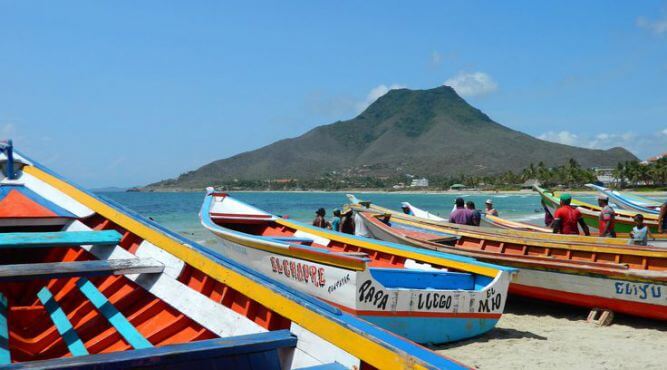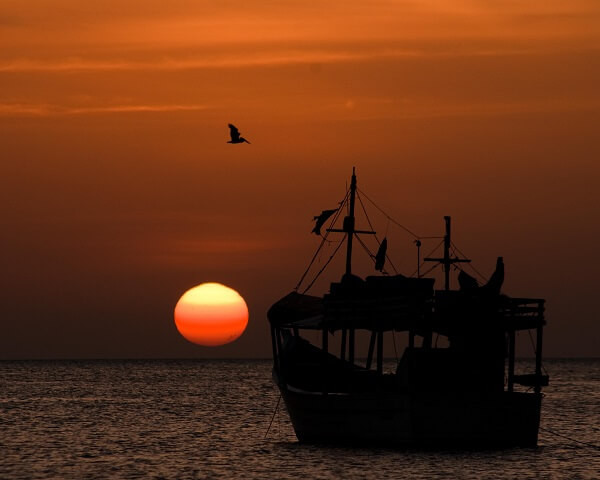Margarita Island (Isla de Margarita, Spanish pronunciation) is the largest island of the Venezuelan State and is situated off the northeastern coast of the country, in the Caribbean Sea. Located in the Caribbean Sea between latitudes 10°52’N and 11°11’N and longitudes 63°48’W and 64°23’W, the island, along with the islands of Coche and Cubagua, comprises the state of Nueva Esparta. The island is split into two peninsulas joined by an 18 kilometres (11 mi) long isthmus and covers an area of 1,020 square kilometres (390 sq mi).
It is 78 kilometres (48 mi) long and measures roughly 20 kilometres (12 mi) at its widest. The 394-square-mile island, with 106 miles of coastline, has much charm.
Somewhat self-proclaimed as in early years it became pretty well known internationally for its pearls.

Isla de Margarita was discovered by Columbus in 1498 and quickly became known for its pearls. Through the centuries, settlements on the island were besieged by Indians (in reprisal for slave raids on the mainland) and by British pirates and Dutch forces.

Angel-Eco Tours is offering a unique trekking experience in Canaima National Park. Few people have made this trek by land, except of course the local Pemón of the Purpurken community.
This is an exciting new addition to our portfolio, something really special..
Ghost Canyon (la Cueva Fantasma) is a magical location deep in Canaima National Park with paths virtually untrodden by tourist. Some helicopters have landed in the mysterious canyon but very few groups have entered by foot – at least any tourists.
The indigenous have made a few trips to the canyon to pave the way for ourselves. Two trips are offered one shorter than the other, the second (two nights longer) hikes up to Aicha Falls and then on to the valley below of Kamarata. Expertly guided by a mixture of the indigenous Pemón tribe (Kamarakotos & Taurepanes). We hike virgin paths through primary rainforest, across plains / savannahs, climbing hilly paths, traversing rivers until we reach the entrance of Ghost Canyon.
Including cultural interaction with the villagers (cultural dancing) of our local hosts.
Groups must be small 2-6 and we encourage bringing something along to help the local “Pueblo”.
The climate is sunny and dry, with an average temperature is 32 °C (90 °F) with minimums ranging between 22 °C (72 °F) and 23 °C (73 °F). Rainfall is common in the winter months; rainy season begins July–October (although the rain is usually quite rare).
To get to the island there are only two options, by sea or by air, both of which have their advantages and disadvantages. By sea you will always have the option to travel by ferry, where you can also transfer cars, an excellent option as it allows greater comfort once you are on the island, if you go independently. The option by plane is also very comfortable as the flight is a little more than half an hour, 45 minutes approximately, for this is highly recommended to opt for a package tour that includes transfers. The excellent thing about the island is that it can be visited at any time of the year and consists of excellent recreational places as well as beautiful beaches.
The island can be reached by direct flights from Caracas or ferries from Puerto la Cruz, Cumaná, and La Guaira. Occasionally international charter flights are welcomed from Europe, however since the pandemia, there have been very few.
La Asunción is the capital of the Federal State of Nueva Esparta with a population of around 28,500. It is the seat of the regional government. The city is overlooked by the Santa Rosa de la Eminencia castle.
Eastern Isla Margarita eastern is formed by a mountain range which runs roughly north–south, from northern Porlamar to Cabo Negro; north from the town of El Espinal, the massif rises steeply to the culminations of San Juan and Copey hills, at heights of 920 and 890 m, respectively.
The Macanao Peninsula has a mountainous spine of the central west–east, with several culminations, including Macanao Peak, which is the highest, with an altitude of 760 metres above sea level stands.

There are a number of nature parks, but Laguna de La Restinga is designated a national park and is the best known, here one can kayak or join special group tours.
The Tetas de Maria Guevara (“Maria Guevara’s breasts”), located in a coastal plain in the south of the 1,670 hectare Laguna de La Restinga National Park, are two small twin hills with a height of 135 metres (443 ft). The area around the hills is desert, with cacti, prickly pears, yaks and guamaches. The fauna is diverse, including desert lizards, rabbits, rattlesnakes and coral.
The legend, as told by the inhabitants Margarita, tells that the name María Guevara comes from a young white girl who was heavily involved in the War of Independence and that upon her death, the hills rose on her grave. Another Margaritan myth says the source of the name also comes from the same woman, but that she was from Cumaná and came to the island to lead a group of men in fishing activities. As she had small breasts, by way of derision whenever they sighted the hills said, “there are the lady’s tits” and the name was created. The area was declared a national park on February 27, 1974.
The urban area of Pampatar has a population of around 50,000. A number of the island’s larger shopping malls are located in the town, namely Sambil Margarita, Rattan Depot, Centro Comercial La Vela, Centro Comercial Costa Azul, Centro Comercial AB (Avenida Bolivar) and La Redoma. The San Carlos de Borromeo Fortress, constructed in the late 17th century, is located in Pampatar. The town also has several beaches.
The largest town on Margarita Island is Porlamar. The population can reach 125,000 in the high season, while in the low season, the population is about 85,000. Two beaches are located within the town. The island’s major airport, Santiago Mariño Caribbean International Airport, is located near Porlamar.
Juan Griego is a town on the northern side of Isla Margarita, and is the most northern port in Venezuela. A census in 2001 suggested a population of 28,256 inhabitants and is the capital of the Marcano municipality of the Nueva Esparta state. Its Gothic-style church, constructed in 1850 by Fray Nicholas de Igualdad, is still, along with the lovely bay, the symbol of the town. The La Galera fortress, where in the early 1820s a fierce battle for independence was fought, is located near the town centre. In 1973, the island become a free port and the city once again become the second city of commercial importance after Porlamar.

Christopher Columbus was the first European to arrive on Margarita Island in 1498. The local natives were the Guaiqueries people. The coast of the island was abundant in pearls, which represented almost a third of all New World tribute to the Spanish Crown. Margarita Island was fortified against the increasing threat of pirate attacks, and some fortifications remain today. It was the centre of the Spanish colonial Margarita Province, established in 1525.
In 1561, the island was seized by Lope de Aguirre, a notoriously violent and rebellious conquistador. Around 1675, the island was captured again, this time by Red Legs Greaves, a pirate known for his humanity and morality. He captured a fleet of Spanish ships off port, before turning the guns on the forts which he stormed and claimed a large booty of pearls and gold. The story of Greaves’ capture of the island does not appear in historical Spanish records and may be fictional.
Construction of the Santa Rosa de la Eminencia castle was ordered by the governor, Juan Muñoz de Gadea, after the French buccaneer Marquis de Maintenon attacked the island in early 1676.
The island gained independence from the Spanish in 1814, after the collapse of the First Republic of Venezuela. It became the first permanently free territory in Venezuela. In the same year, Luisa Cáceres de Arismendi was detained in a dungeon of the Fortress of Santa Rosa on the island in an attempt to put pressure on her husband Juan Bautista Arismendi, who was fighting for independence. Her detention lasted for over three years.
Simón Bolívar was confirmed as Commander-in-Chief of the Second Republic of Venezuela on the island in 1816. From there, he started a nine-year campaign to free Venezuela, Colombia, Ecuador, Peru and Bolivia from the Spanish Crown.